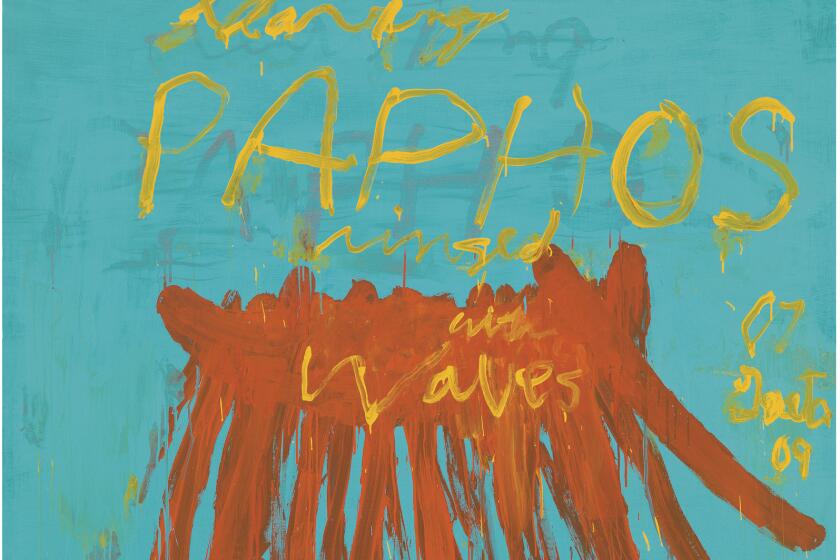Review: At MOCA, painter Tala Madani playfully smashes the patriarchy with pie
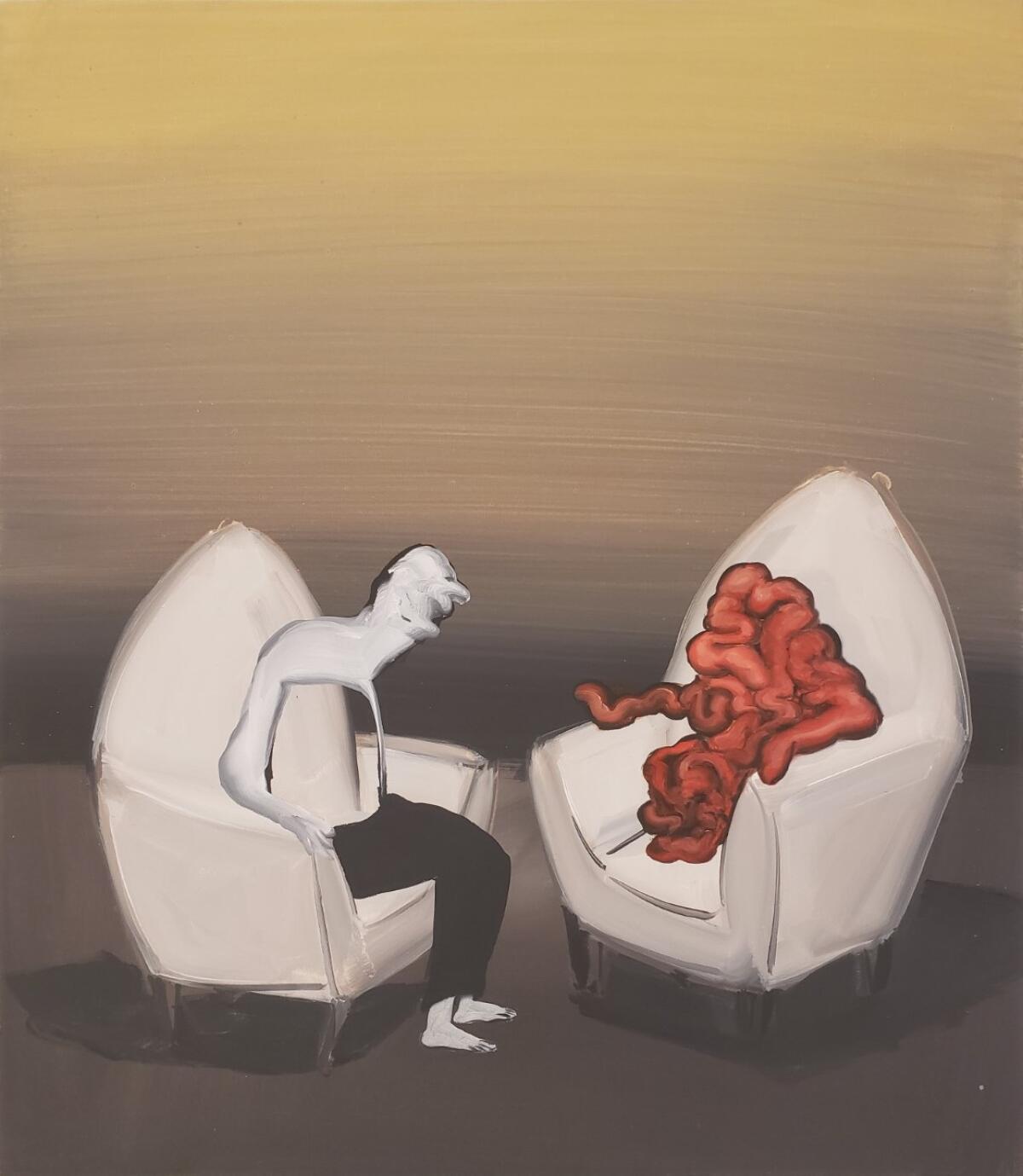
During a 1977 press conference in Des Moines, Iowa, a gay rights activist threw a pie in the face of faded pop singer and flourishing fundamentalist Christian Anita Bryant, who was deep into her noxious national crusade against homosexuals. Bryant, ever the bigot, hurled back a slur in response, naming the whipped-cream projectile a “fruit” pie.
The combative media moment was widely broadcast, and, for a while, powers-that-be getting “pied” became a thing. A showy act of theatrical protest, the event was at once very funny and inescapably cruel — a wacky bit of Three Stooges slapstick that also amounted to angry physical assault. Morally, emotionally, practically, it made a mess.
In 2005, artist Tala Madani made a small, somewhat cartoonish painting on a hefty chunk of wood panel that upped the ante of being pied, while turning the violent humor inside out. It also launched her artistic direction. In the earliest work included in the sprawling, alternately hilarious and eye-popping midcareer survey of the Iranian-born, American-educated, L.A.-based artist at the Museum of Contemporary Art’s outpost in Little Tokyo, a rather burly, grinning man in a tank top is shown smushing a cake in another man’s face.
The encrusted paint is thickly, almost clumsily applied — caked, as the painting’s title also has it, describing the visual action. Form and content coincide.
The assailant’s raised arm is ramrod straight, underscoring the force behind the action. The target’s ham-handed arms hang limply at his side, as if, like Bryant, he has been blindsided by the slapstick assault. “Let ‘em eat cake” gets a combative, dismissive twist, mixing formal acuity with satirical subject matter.
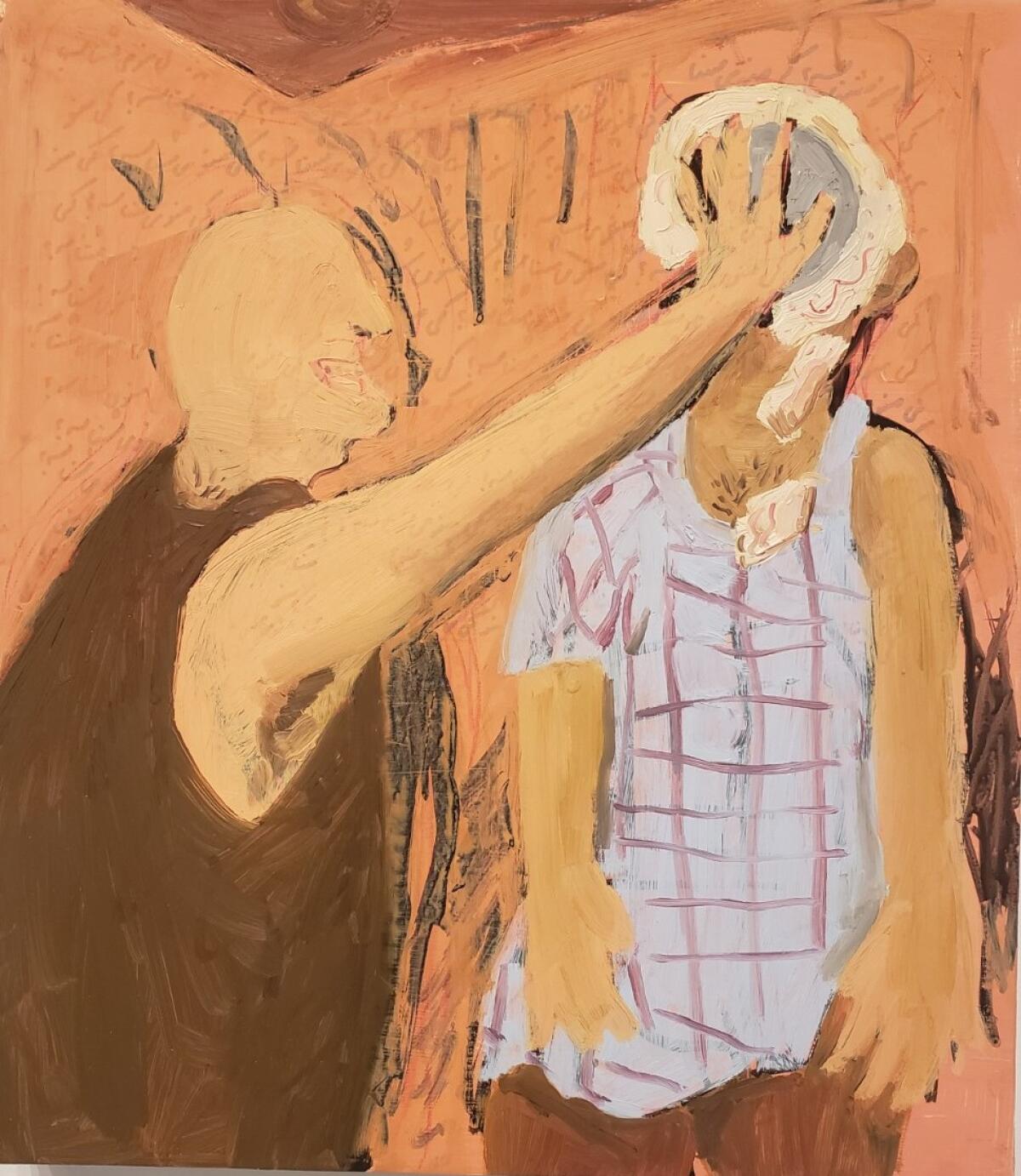
Madani’s picture is one from a group of small works collectively titled “Cake Men” — she often works in series — a cavalcade of crude guys who engage in an absurd range of homosocial activities. They blow out candles with unwittingly erotic gestures, balance those flame-topped symbols of spiritual illumination atop resolutely closed eyes, munch hungrily (and sloppily) on nutrition-free frosted treats. The men are gross, buffoonish and sad. If they have artistic cousins, they’ll be found in Philip Guston’s trenchant paintings of hooded Klansmen begun in the late 1960s.
Madani, 41, plays with cultural stereotypes of family and social life, including childhood innocence, parental power, masculine authority and sexual drive. (The show is fun for the whole family, but only if the adults are willing to be candid and astute with the kids about occasionally X-rated material.) She left Iran’s big and bustling capital city, Tehran, with her family at age 14, the year that the United States began to impose sanctions in response to Iranian support for Hezbollah, Hamas and other terrorist organizations, landing in a tiny town in the Pacific Northwest.
Her paintings and video animations are informed by an appropriately shellshocked view of humanity — especially male — which she struggles to grasp. Perhaps tellingly, Madani’s two undergraduate degrees (she also has a Yale MFA) are in visual art and political science.
The show’s entry gallery sets up what is to come. A recent, billboard-size canvas titled “The New Landscape” shows a group of men looking out toward rolling hills in the distance. Slowly the placid landscape reveals itself as a man’s torso, seen lying down on his stomach with legs spread wide, mooning a viewer. Our conventional projection of feminine traits onto landscape, starting with Mother Nature, is replaced by a man’s gaping anus. The hands of the fellows reaching out toward it are covered in a mud of feces.
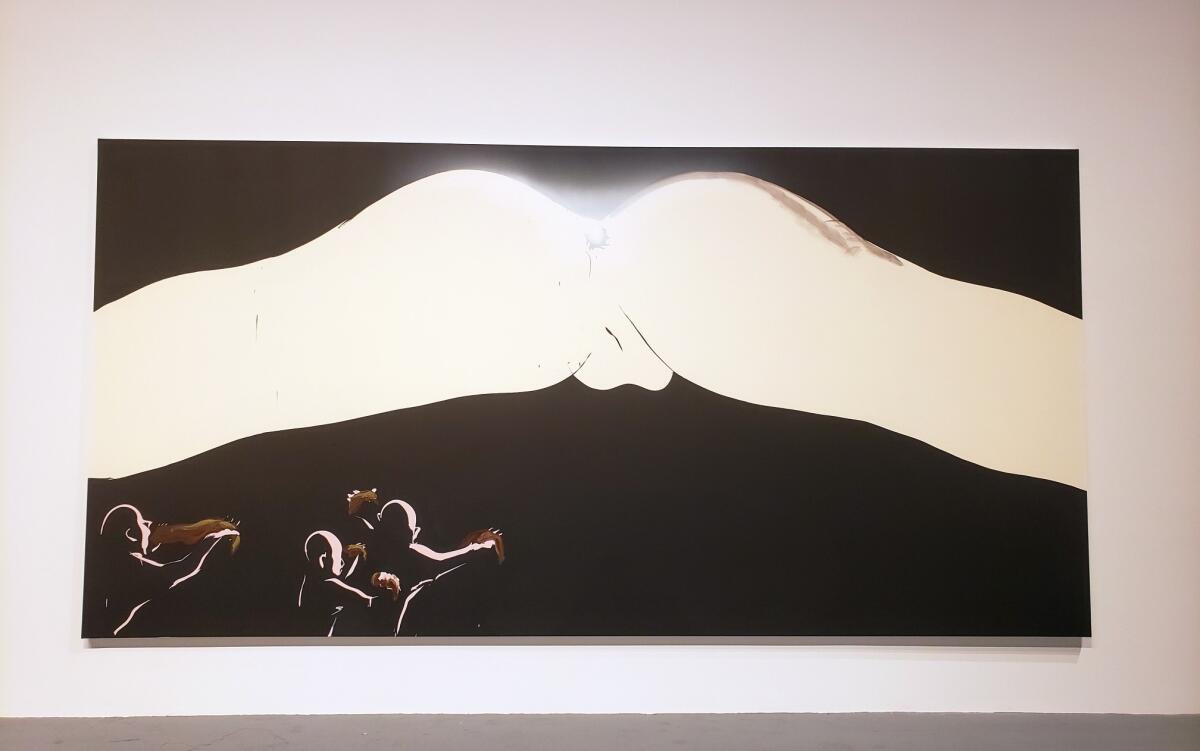
A stentorian chorus of “Climb Ev’ry Mountain” runs silently through your head. Smashing the patriarchy, author of worldly views, is rarely this much seductively, complicit fun.
Take “Guts,” a small painting also blown up on a poster above the entry to the Geffen Contemporary, which welcomes in visitors. (It’s not to be confused with Samara Golden’s “Guts,” an elaborate Night Gallery installation from earlier this year.) Like a painterly academic discourse on the meanings of Expressionism crossed with an outtake from Gary Larson’s “The Far Side,” the image juxtaposes two upholstered side chairs, pulled together within a bilious abstract space (think Ed Ruscha’s smoggy skies). A clownish chattering man, his punctured belly a see-through hole, attempts a comfortable conversation with his own bloody red innards, piled up in the other seat. Vaunted claims for the power of an inner life are lampooned.
A new show at the Getty offers a focused look at abstract painter Cy Twombly’s obsession with ancient Greece and Rome.
A character named Pussy turns up in four large canvases like an escapee from a children’s book. The demure little girl sits on the floor, knees pulled up close, her sex accidentally exposed beneath her dress. It’s a bit of a shock, until you recognize that it’s an innocent revision of Gustave Courbet’s famous fleshy pose for the voluptuous woman in his 1866 painting “The Origin of the World.”
In one of the four, the girl is outlined by concise strokes of red and green paint against a flat black background, with a trio of fat, balding men bobbing across the bottom of the canvas. All have donned their 3D eyeglasses, aiming to get a gander at something they otherwise could not see. The composition loosely suggests men seated inside a movie theater; light reflects off them, as if bounced from a screen, onto which their illusions are projected and then reflected back onto them in a closed loop.
In another, a man holds up a Kandinsky-style painting of floating squiggles and geometric shapes, trying to make sense of a mysterious, alien abstraction. Like a cartoon drawing by Ad Reinhardt, the most rigorous of American abstractionists, he points excitedly beneath the girl’s skirt, presumably where an explanation might be found. Three other men crawl toward the art on hands and knees, leaving slimy trails behind, drawn like slugs to carrion.
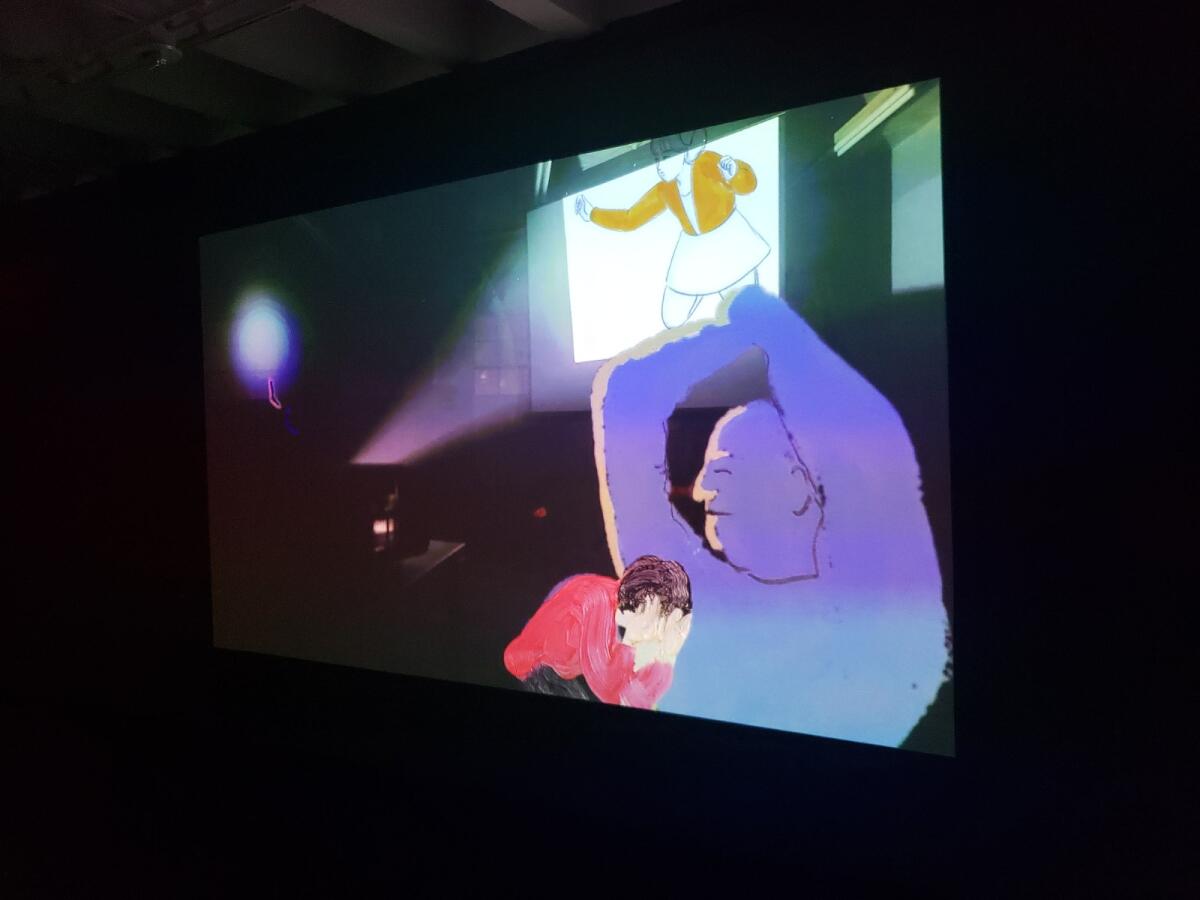
In both paintings, the men are Lilliputian while the figure of the little girl is monumental — a suggestive projection of their erotic desires, one unfolding in a movie theater and the other in an art museum. In fact, projectors turn up repeatedly in Madani’s show, sometimes simply depicted, sometimes suggested by sharp beams of light cutting through dark spaces, and sometimes inherent in animated films.
One of those animations is centered on a similarly posed young girl now wearing a bright yellow sweater, who is indeed a movie projection shown up on a screen inside a darkened theater. An older man and a younger one — father and son, perhaps, or a more general evocation of generations of men — stare at the sweet young thing lighting up in the darkness.
Suddenly she stirs, leans forward and, becoming momentarily monstrous and threatening, bursts out from the flattened movie screen and into the space of the darkened theater, scooping up the two guys and pulling them into her world. She promptly disappears them up her dress, then returns to her placid life as a remote pop culture image.
Madani’s animations are drawn frame by frame, which gives them a jumpy, handmade feel rather than being the sleek product of corporate or desktop digital production. One room of the show is wallpapered in a printed motif of enormous leaves, smeared here and there with giant slathers of fecal brown paint, on which paintings hang. Eden proposed as a messy place of human creation comes to mind, albeit in a thoroughly secular way.
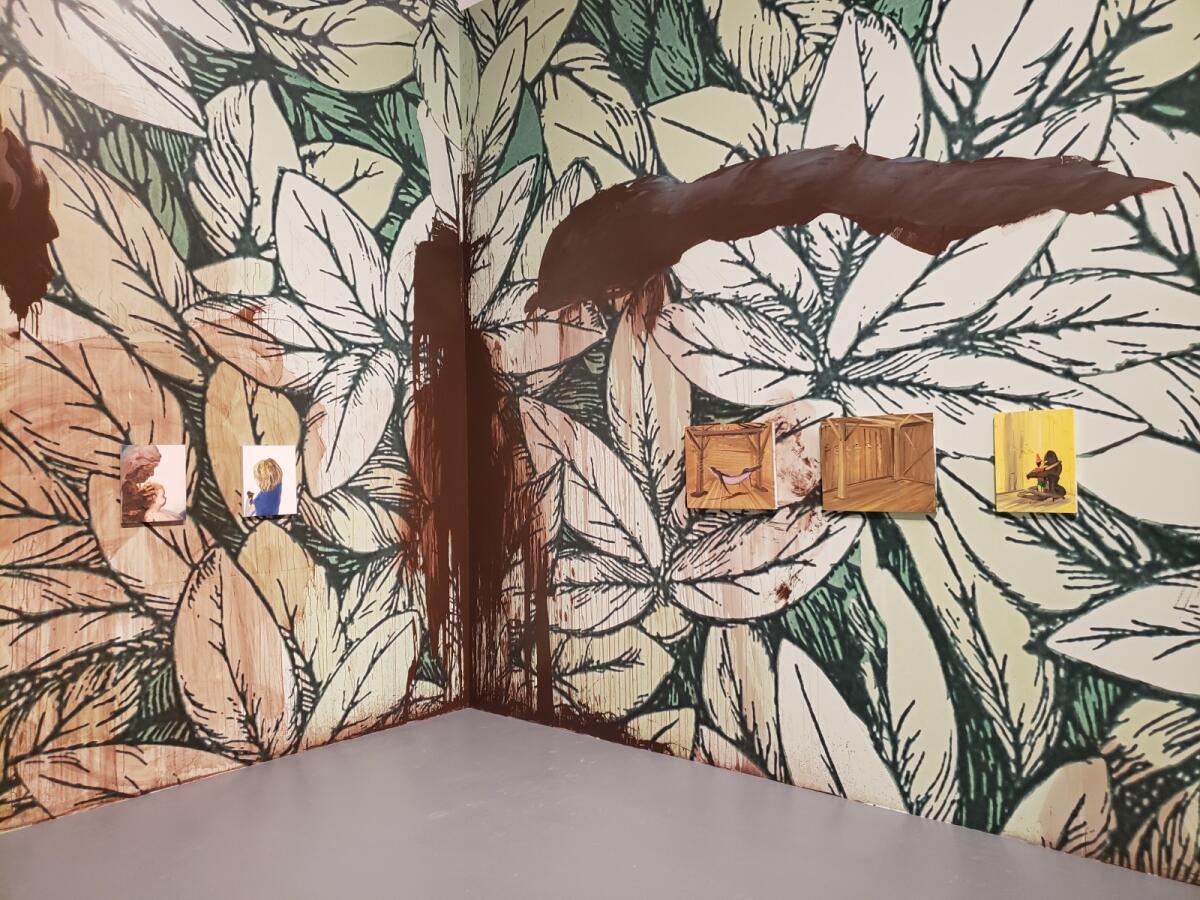
Madani’s work is like a truant love child of scatological transgressions by the late Mike Kelley and the feminist media smarts of artist Barbara Kruger. Deftly organized by MOCA curator Rebecca Lowery, guest curator Ali Subotnick and curatorial assistant Paula Kroll, and accompanied by a very good catalog, it carries the curious title “Tala Madani: Biscuits.” An aghast utterance — made up and vaguely patrician, like a socially acceptable vulgarity sputtered by an annoyed King Charles III — “biscuits” is an exclamation of sheerest absurdity, about which you want to know more.
'Tala Madani: Biscuits'
Where: The Geffen Contemporary at MOCA, 152 N. Central Ave., Los Angeles
When: 11 a.m.-5 p.m. Tuesdays through Fridays, 11 a.m.-6 p.m. Saturdays and Sundays. Closed Mondays. Through Feb. 19.
Info: (213) 626-6222, moca.org
More to Read
The biggest entertainment stories
Get our big stories about Hollywood, film, television, music, arts, culture and more right in your inbox as soon as they publish.
You may occasionally receive promotional content from the Los Angeles Times.
